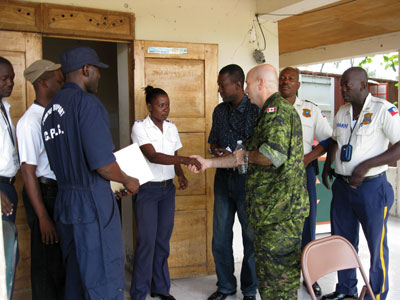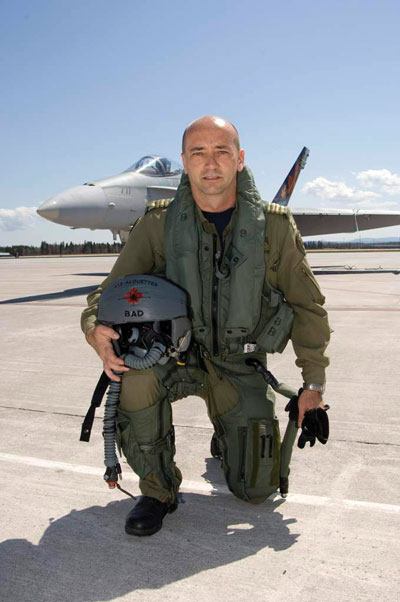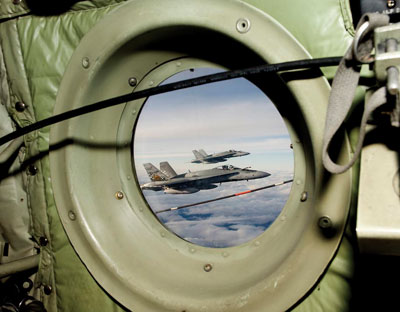
Features
Military
A Commanding Force
If there’s one man in the Canadian Forces who has his finger on the pulse of all rotary- and fixed-wing activity, it has to be Maj.-Gen. Yvan Blondin – and he wouldn’t have it any other way.
May 9, 2011 By Paul Dixon
If there’s one man in the Canadian Forces who has his finger on the pulse of all rotary- and fixed-wing activity, it has to be Maj.-Gen. Yvan Blondin – and he wouldn’t have it any other way.
 |
|
| Maj.-Gen. Yvan Blondin greets Haitian officials at the Jacmel airport after Canada started flying C-130s into the 3,000-foot runway during Operation HESTIA. photo: dnd
|
The Montreal native joined the Canadian Forces in 1980 and has steadily risen in the ranks. A CF-18 pilot with more than 3,000 hours on type, he is today, as the commander of 1 Canadian Air Division and Canadian NORAD Region, the one person responsible for the people and machines that comprise today’s Canadian Air Force. Fit, trim and relaxed, Blondin spoke with Wings in his Winnipeg office about his colourful career and the status of some the AF’s most important assets.
Q| How did you come to join the Canadian Forces?
A| I was 21, going to school and needed a job. I answered a classified ad for an insurance salesmen but after the interview, I knew they weren’t going to call me back so I was pretty much out of options. My car just happened to be parked in front of the recruiting centre, so I thought “what the hell, let’s go have a look inside.” I went inside and asked, “do you have any jobs here?” The person behind the counter asked me what I wanted to do. I saw a poster behind his back of a pilot in a dark green flying suit standing by a jet and I thought that looked good. So, that’s how the Air Force reeled me in. When I went home and told my mother that I had joined the Air Force and was going to be a pilot she thought I was joking.
I arrived in Portage the next summer for flight training and I’d never been in an airplane before. My first flight, in a Muskateer, scared the hell out of me. I couldn’t wait to get back on the ground. You go up and fly again the next day because you’re more scared about what the other guys are going to say about you than what the airplane can do to you.
I was in it all for the adventure, just for five years, and then I was going to get a real job. After five years, I was posted on the CF-18, a brand new airplane. Then, at the end of nine years, I thought I would leave because they give you a year’s pay (as a bonus) and I could get a real job. But by then, I was involved with the CF-18, and I was doing something I was happy to do and being paid to do it. Here I am 30 years later, haven’t found a real job yet and just loving it.
Q| Your role has changed significantly over the past 30 years. Can you explain the breadth of your position as Major-General?
A| I’m in charge of all Canadian Air Force operations. It’s a great honour, the responsibility of being able to lead and make a difference. It’s certainly not a regular office job. The span of operations, Afghanistan, air security operations in Canada for CANADACOM, NORAD operations, operations for the Canadian north region . . . I’m also responsible for force generation, mission capability, developing pilots and air frames, so we can use them during operations.
It’s true the technology is great, but flexibility is the key to air power and this is where I exercise flexibility, having control of all the levers so that we can deliver the best effect in the end. Over the past three years, we’ve had some big challenges, any one of which would be big enough on its own.
Q| What are those challenges and how do you manage human assets, especially given all the operation levels you oversee?
A| The first challenge is the people one. We downsized [in the 1990s] and we didn’t recruit. When you do this, you end up with a lot of young and lots of old, with nobody in between. The experienced folks are really what make it work, but they are the ones retiring. So, I’ve got lots of new folks coming in and we’ve been recruiting, doubling the rate of recruiting the past two or three years. It’s great to see all those new people coming in, but by the time we recruit them, train them and get them experienced, there’s a period of three or four years that they’re not useful to me. They’re actually a drain on assets, because I need to use experienced people to train them to get them up to speed. I’m operating probably with about 80 per cent of effective manning into my units.
 |
|
| Maj. Gen. Yvan Blondin walked into a recruiting office and pointed to poster of a pilot and said, “that looks good.” PHOTO: DND |
This people challenge, when you couple it with the transition from old aircraft to new aircraft, is also a concern. Having new aircraft is great. With seven new fleets in 10 years, we’ve never seen that in the Air Force. But when you get a new fleet, there’s a period of learning. There’s a period of not just learning to fly it, but also how to maintain it, to ensure you’re using it effectively. To get the best effect, it takes time.
Another key challenge is that we are so busy with operations. We took Chinooks that were virtually scrapped in Afghanistan, turned them around, qualified on them, started doing operations and we’ve been successful for the past year. We’ve done that in a combat theatre. And if you do this with the C-17, do this with the Cyclone, do this with the Chinook, it takes people away – and it’s people I don’t have here to use the older aircraft. So, to try to go from one to the other has been a challenge.
Q| How has the role of the Canadian Air Force changed over the years, and what is the primary focus now?
A| The pace of operations has been unprecedented in the past 30 years. If you look at the 1940s and ’50s, when we had the Second World War and then the Korean War, we had operations ongoing with a huge Air Force and plenty of new people. After that, until the ’90s, it was 40 years of training. We didn’t have operational missions like we do now. For every one person that you deploy, you’ve got another one in training and one just coming back.
In the past year, we knew that supporting Afghanistan would be a drain on what we did. We knew with the Olympics coming up, we needed to prepare early, train people early, be careful in scheduling, deciding who would be used for what, whether they would be deployed to Afghanistan this year or next. We actually told people to take their leave early in the year because we thought it was going to be busy after Christmas for three months. We arranged the training schedule with the different operational training units so we had enough assets to support Afghanistan and the Olympics.
So, when Haiti came up right in the middle of the operations, it wasn’t a question of whether we could do it or not. It was, “OK, we’re going to Haiti.” Because I control everything, I could decide to slow down a bit on training for helicopters because I needed a six-pack to go to Haiti. It was easily co-ordinated and done. We could use the flexibility we needed, and within 12 hours, we had a plan on how we were going to support Haiti – and how we could do other operations because everything was controlled out of here from the CAOC [Combined Air Operations Centre]. Every day for the first two weeks, we were having video-conferences daily with Ottawa, Vancouver and everybody involved with the different operations, to see where the stresses were and what we needed to adjust to be able to support.
Q| So, you’re functioning today at a level that wouldn’t have been possible in that old regime, during the Cold War?
A| During the Cold War, we didn’t have that flexibility. We didn’t have the same operational mindset or the same qualifications. Actually, the people principle is probably what makes us successful. The motivation is just unbelievable. If I keep them busy, if they’re doing operations, they just love it. When we do something it’s more than just getting the pay, it’s like you make a difference, like you’re useful, especially doing all this and the tremendous support we’re getting from the population.
Q| Canada is poised to replace 138 CF-18s with 65 of the hotly debated F-35s. How is this possible?
A| When we bought the F-18 we bought 138, but we had three squadrons of F-18s in Germany at that time. We were supporting four operational squadrons in Canada plus an OTU, so we were supporting eight squadrons with 138. Right now, we are operating with around 78 F-18s, but there’s a huge inventory at the OTU, so if you look at my four squadrons, I’m operating with 13 or 14 planes per squadron today. The F-35 is planned to be 12 per squadron with four squadrons, but it is assuming we’re going to have an OTU, which would have 15 to 17 airplanes.
 |
|
| CF-18 Hornets from 409 Tactical Fighter Squadron, 4 Wing Cold Lake, refuel from the CC-130 Hercules during Operation PODIUM. PHOTO: Cpl. Jax Kennedy, DND |
We still need to decide how we’re going to train the pilots, because part of the F-35 concept, the international concept, is they are going to provide an international training unit in Texas. The proposal is that countries will send their pilots to be trained on the F-35 at that unit and then move out to their country once they are qualified on the airplane. So, the advantage of going with the international OTU is that you don’t need a fleet of 15 airplanes.
With the F-18, we can still support it until 2020, but by 2016 there’s a point where there is too much strain and fatigue on the airframe and we’ve got to start parking them. So, in 2016 our numbers start to come down and by 2020 we won’t have the numbers to have an effective force of F-18 squadrons.
I can do the job with 65. If we decide to have our own OTU, if you look at how we do the training with the F-18, I’d say about 70 per cent of the training is being done in flight with some duals and singles. With the F-35, you optimize the training by simulation, so there are no duals. The first time you fly is in a single, all your training before you fly off is done on a simulator. Taking advantage of advanced technology there’s a lot more you can do with simulators. You need less hours on airplanes, so we wouldn’t be using 25 airplanes like we do today for the training.
Q| You have many people who report to you, but by the same token, you have different people you report to above you, depending on the situation. Do you find that difficult?
A| I provide the air support, so it’s just that different missions have different bosses. I’m really the facilitator, the co-ordinator. I make sure that I advise them the best way possible – and ensure we can still do other missions. It’s all about having one point of co-ordination and offering the best use of resources available, because I can play with everything. I can slow things down, because everything is based on force generation capabilities. It’s all about training. I need hours to train my new pilots, qualify them. That requires a lot of available resources. The more I use for that, the less I have for force employment and operations. When something comes up, I can say, “slow down,” let’s slow down on this and we can catch up later, re-adjust. If there’s a mission out there to be done, we’ll do it. So, I wouldn’t want to separate those hats, they need to be together.
Q| What are your thoughts on the Family Support Initiative and how different is a military career today compared to several decades ago?
A| The more I talk about operations, the more the guys want to do them. But when you deploy people for six months and they come back, it’s tough on the family. The problem we have with attrition is not necessarily coming from the guys. I can keep them interested, they love what they are doing, but when the spouse says, “I’ve had enough,” I lose a guy. If I don’t take care of the family, I’ve got a problem. So, we’ve put a lot of effort into supporting people. If I’ve got someone coming back with psychological problems from an operation in Afghanistan, it’s not just that person who has the problem; the wife and the kids are having the same problems. Even if there are no psychological problems, repeated operations abroad has an effect on the family.
Q| So, the CF is much more concerned about looking after its human assets today?
A| When I joined 30 years ago, they would ask me which posting interested me, but we knew we were just going to go where we were told. It’s much different today. We consult. We ask people . . . what about moving this year? What about next year? We make long-term plans. We’re much more flexible in our approach, trying to consider family issues, family obligations, location preferences. It’s not because we want to be nice people. It’s what you need to do if you want to retain people.
The truth is, the only reason we are successful in our operations is because of the people who make it work. If I can retain the good people, and just let them do their job, they will work miracles. It’s not the equipment that makes us different from other Air Forces; it’s the people flying it and maintaining it that make the difference. It’s what I see in everything we do. It’s a highly professional force; we’re a small, but elite force.
Q| Risk is an important part of any Air Force mission. How do you manage risk – and does it ever worry you?
A| You’re always operating at the edge of your capabilities, having to make the call: do we do it or not? But if we don’t do Search And Rescue in bad weather, who’s going to do it? It’s always about risk management. How much should we do and how much do we not do? It’s a tough question. If we go to Haiti, how far do we push, where do we stop?
Everything is about pushing the limits but keeping it within safety parameters. After all, managing risk is my bread and butter. Every day, there’s another decision, always based on the risk. There’s a lot of stuff being done here – but that’s what makes it enjoyable.